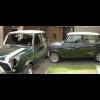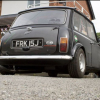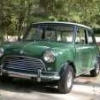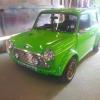Starting engine after rebuild
#1

Posted 07 March 2007 - 09:34 AM
Are there any tips for starting the engine up again? I've begun by cranking it on the starter with all the plugs out until the battery went flat, to try and get some oil circulating. It still feels quite tight at present though - with the plugs in, the starter struggled badly to turn the engine over more than one turn at a time. I've currently got the battery on charge, but is the starter going to be sufficient to fire the engine up, or am I likely to need to bump start the car or use some other trick to get it running again?
#2

Posted 07 March 2007 - 09:52 AM
I've just finished rebuilding a 1275 engine with new pistons/rings, new shell bearings, new oil pump. I lubricated everything generously during the rebuild but due to waiting for parts and the time taken to put everything together, most of that has inevitably trickled down into the sump by now.
Are there any tips for starting the engine up again? I've begun by cranking it on the starter with all the plugs out until the battery went flat, to try and get some oil circulating. It still feels quite tight at present though - with the plugs in, the starter struggled badly to turn the engine over more than one turn at a time. I've currently got the battery on charge, but is the starter going to be sufficient to fire the engine up, or am I likely to need to bump start the car or use some other trick to get it running again?
Not an expert in any means but if the battery is struggling to turn the engine over I think that bump starting is a good place to start
#3

Posted 07 March 2007 - 09:54 AM
There is a technique for starting an engine after a rebuild, it has been written on here a few times, so a search should find it
#4

Posted 07 March 2007 - 12:02 PM
If your engine feels tight and you have turned it over without priming the oil at all then I guess it could be starting to pick up on a bearing somewhere.
By "priming the oil", do you mean pushing the car back and forth in gear to get some oil circulating? I did this a few times before trying to turn it on the starter.
There is a technique for starting an engine after a rebuild, it has been written on here a few times, so a search should find it
I've searched pretty extensively (or so I thought), but I must be using the wrong search terms
I've found a few threads about tight engines, but only these two sound similar:
can anyone help me please
new engine too tight
These seem to suggest either:
1) Faulty/missing earth strap, i.e. starter not getting enough juice to turn the engine fast enough (or at all).
My car only has a single strap which goes from the servo to the inner wing. It started OK with this setup before the rebuild. After operating the starter for about a minute, the battery earth strap in the boot was quite warm. Would this indicate the need for an additional earth, or is it just down to the extended time spent with the starter spinning?
2) incorrect fitting of the crank/big end shell bearings, or incorrect shell bearings
Short of removing the engine again I can't easily check, so I really hope not! The engine was only dismantled to replace pistons/rings/oil pump and the crank was not removed, I just checked all bolts for the correct torque (all were OK). The conrods are offset and so can only go on one way. They were replaced in the same order in which they came out. The new big end shells were checked against the old ones for size and I am 99.99% sure that the keyways were fitted adjacent to one another - from memory this was dictated by common sense as there was a small but obvious step where the two shells meet if attempted any other way.
#5

Posted 07 March 2007 - 01:11 PM
Were the engine not in the car I would have suggested that you pull the plugs as you have done and turn the engine over on the stand using a socket wrench on the crank pulley. With new rings and bearings it will be tight but my experience is that it's not so tight that the starter struggles exceedingly.
There are several ways to prime a dry oil system. Start by taking the filter off and manually filling it before installation. After that you can undo the banjo bolt on the block and pour engine oil DOWN the tube to the filter head while turning the engine 'backwards' by pulling on the belt and front pulley. This will fill all the oilways back to the pump. After you've done this for several revolutions, put the banjo bolt back in place. Install an oil pressure gauge (if you haven't already) then turn the engine over on the starter (w/o the plugs installed) until you see oil pressure on the gauge.
#6

Posted 07 March 2007 - 02:40 PM
Hindsight is always 20-20.
Were the engine not in the car I would have suggested that you pull the plugs as you have done and turn the engine over on the stand using a socket wrench on the crank pulley. With new rings and bearings it will be tight but my experience is that it's not so tight that the starter struggles exceedingly.
There are several ways to prime a dry oil system. Start by taking the filter off and manually filling it before installation. After that you can undo the banjo bolt on the block and pour engine oil DOWN the tube to the filter head while turning the engine 'backwards' by pulling on the belt and front pulley. This will fill all the oilways back to the pump. After you've done this for several revolutions, put the banjo bolt back in place. Install an oil pressure gauge (if you haven't already) then turn the engine over on the starter (w/o the plugs installed) until you see oil pressure on the gauge.
Thanks for the tips about priming the oil system, I'll put those into practice when I have another try this evening.
Prior to refitting the engine I was able to turn it as you describe, using a socket and 6" bar on the crank pulley. It was certainly quite tight but I was able to get a full revolution without too much effort and without any oil in the engine. As a result of the problem described in my Pre-verto clutch woes thread the other day, I then removed the flywheel housing and assembly with the engine in the car in order to fit a replacement clutch plunger. When putting the flywheel assembly back on, the engine did at least two full revolutions while tightening the three diaphragm housing bolts. It's too tight to turn by hand using the belt/pulley though.
One oddity I have noticed when pushing the car in gear is that the fan pulley seems to stick slightly at a certain point of the rotation, to the extent that the belt slips and the fan stops rotating momentarily. This doesn't happen when using the starter. I've had a word with a mechanic this lunchtime and he suggested either a sticking water pump or fan. Neither seem to make much sense though - the water pump is in good condition and turns OK on its own and the fan doesn't seem to be catching anywhere (I'd have thought that would be fairly audible/visible). In any case, when I turned the engine while tightening the diaphragm housing bolts, the engine was in the car and everything on the radiator end was connected. If something was amiss I'd have expected it to be fairly obvious at that point.
All in all I'm still wondering if I've done something silly like fitting one or more shell bearings incorrectly. On one hand I imagine this would have made turning the engine by hand very difficult/impossible, but on the other I don't really understand why the starter is having so much trouble at this stage.
I think next step is to check the engine earth strap and battery. Not sure after that, perhaps try a jump start using my GT-Four
#7

Posted 07 March 2007 - 02:44 PM
I think next step is to check the engine earth strap and battery. Not sure after that, perhaps try a jump start using my GT-Four
|
Yeah, sounds like a jump may be the next step, after trying the oil prime technique that DK has described.
#8

Posted 07 March 2007 - 02:59 PM
I think next step is to check the engine earth strap and battery. Not sure after that, perhaps try a jump start using my GT-Four
|
Yeah, sounds like a jump may be the next step, after trying the oil prime technique that DK has described.
I reckon this guarantees the engine will either start, or melt trying...
#9

Posted 07 March 2007 - 05:46 PM
I haven't read your other thread (if this was discussed there). Can you explain the sentence above? I assume you mean that you removed the clutch cover, not the housing. Is that right? If so, did you remove the flywheel from the crank and then re-install it? Did you have to remove any damage to the crank or flywheel bore? On my flywheel, there was sufficient damage to its tapered bore that after clean-up and lapping to the crank tail the flywheel moved up so far on the crank that the ring gear contacted the clutch housing. For every 0.001" removed off the OD of the crank (or inside of the flywheel bore) the flywheel moves about 0.007" towards the clutch housing. If your flywheel or crank taper were questionable, it could be that upon reassembly your flywheel or ring gear is now dragging on the aluminum housing.
I hate to suggest it, but since you're having this much trouble turning the engine over, you may have justification to remove the clutch cover again and carefully inspect the flywheel and clutch to make sure nothing is hitting.
#10

Posted 07 March 2007 - 06:06 PM
I would check you have oil pressure etc as above.
Set the dizzy to TDC and plug 1.
Set the mixture and idle abit higher then normal. this will help get the car started and once you have it running you can adjust as required.
Also...dont press the clutch when starting up. Make sure the clutch nuts are adjusted, so when you do press the clutch you dont push too far/too much force as this can cause the crank/bearings to chaff inside the engine.
#11

Posted 08 March 2007 - 09:04 AM
" I then removed the flywheel housing and assembly with the engine in the car in order to fit a replacement clutch plunger. "
I haven't read your other thread (if this was discussed there). Can you explain the sentence above? I assume you mean that you removed the clutch cover, not the housing. Is that right? If so, did you remove the flywheel from the crank and then re-install it? Did you have to remove any damage to the crank or flywheel bore? On my flywheel, there was sufficient damage to its tapered bore that after clean-up and lapping to the crank tail the flywheel moved up so far on the crank that the ring gear contacted the clutch housing. For every 0.001" removed off the OD of the crank (or inside of the flywheel bore) the flywheel moves about 0.007" towards the clutch housing. If your flywheel or crank taper were questionable, it could be that upon reassembly your flywheel or ring gear is now dragging on the aluminum housing.
I hate to suggest it, but since you're having this much trouble turning the engine over, you may have justification to remove the clutch cover again and carefully inspect the flywheel and clutch to make sure nothing is hitting.
Sorry as you guessed I meant cover, not housing. The flywheel was removed, but there was no damage to the flywheel bore or the crank. I turned the engine over at least twice while tightening the diaphragm housing bolts and everything behind the clutch cover is definitely moving freely throughout 360 degrees.
Success! Managed to get it running briefly last night with the use of some jump leads and a Kubota tractor on fast idle. Even the monster battery on the tractor took about four or five attempts, so the poor Mini battery didn't have a chance from the beginning
Switched it off soon after to avoid gassing myself in the workshop, but appears to be running OK with no obvious problems or funny noises.
Timing will be checked in the next day or so but was only done a few weeks ago and should still be OK (I think) - camshaft/dizzy/timing chain were all left untouched during the rebuild.
#12

Posted 09 March 2007 - 09:36 AM
The engine sounds pretty good - a tiny bit ticky where the valve clearances are slightly out, but I had a good listen to both the top and bottom end via a long screwdriver held against the block and it all sounds pretty smooth in there. It was nice to hear the engine audibly loosening up as it ran too
The most pleasing things are that no 1 cylinder now has good compression and the engine isn't burning oil, so in that respect the rebuild has been successful
Going for a gentle drive later and plan to run things in slowly, fingers crossed all is now OK though. Thanks to all who replied for your advice.
1 user(s) are reading this topic
0 members, 1 guests, 0 anonymous users

















